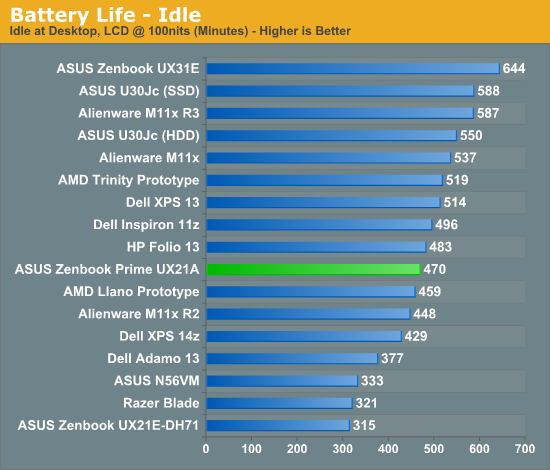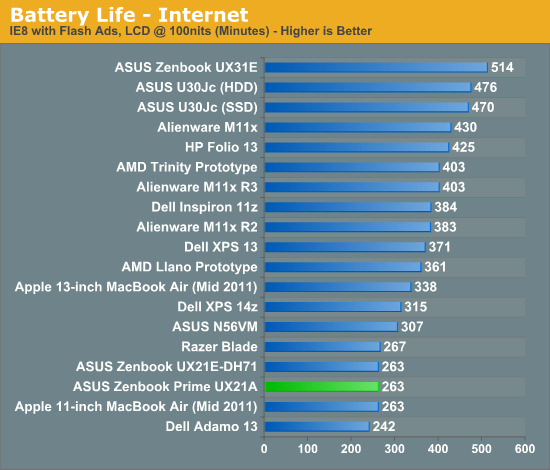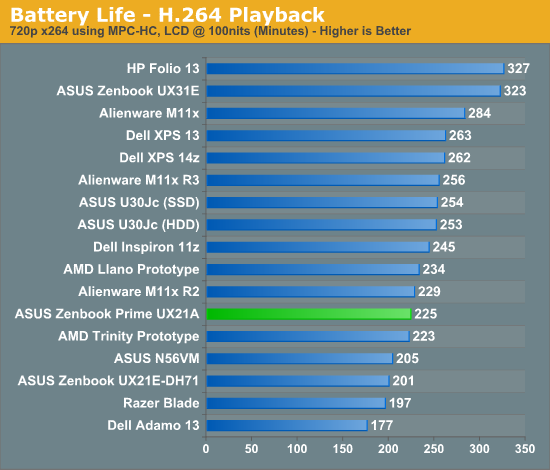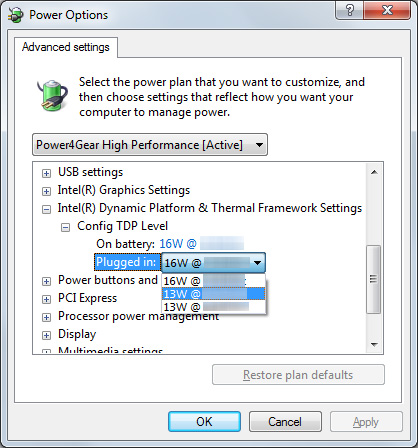ASUS Zenbook Prime (UX21A) Review: The First of the 2nd Gen Ultrabooks
by Anand Lal Shimpi on May 22, 2012 2:46 PM EST- Posted in
- Laptops
- CPUs
- Asus
- Ivy Bridge
- Zenbook
- Zenbook Prime
- Ultrabook
- Notebooks
Battery Life
Generally speaking, the 11-inch Zenbook Prime delivers about the same amount of battery life as its predecessor. For some reason we're able to hit much longer idle battery life on the Prime than the original Zenbook although I'm still trying to find out why. There's also an 11% improvement in our x264 playback test, but on average I'd expect to see similar battery life to the Sandy Bridge model - just with better performance. Note that these results also come despite the fact that ASUS is driving a much higher resolution, and presumably higher power, display than the original Zenbook.



The Zenbook Prime bucks the trend Jarred saw with the first Ivy Bridge notebook review where battery life took a small step backwards. These results bode well for future Ivy Bridge notebooks and Ultrabooks. It still remains to be seen if Intel's 22nm process will actually give us a battery life advantage in any notebook compared to its predecessor. It's possible that we are seeing some of the benefits of 22nm here already and they are simply offset by the more power hungry display. With the move to 22nm Intel should have a better hold on active power and leakage, but it's always possible that we'll have to wait until Haswell for the process to really be exploited.
Just like last time, ASUS has a couple of widgets to quickly change between power settings. The instant on widget lets you switch between suspend to RAM and suspend to disk modes. The former is expected to deliver up to 2 weeks of standby battery life, while the latter can push up to 150 days. I didn't have the time to test these claims (life is short, I draw the line at spending it testing claims of 150 day standby battery life). ASUS once again includes a counter that estimates how long your system will last in either mode based on current charge levels and power usage.
The next widget is a quick tool to let you switch between high performance and battery saver Power4Gear power profiles. You can customize these profiles via the Windows control panel, but it's nice to have a button on the desktop that lets you quickly switch between them.
Configurable TDP
One feature of Ivy Bridge that we haven't been able to test until now is configurable TDP. While most Ultrabook CPUs ship with a 17W TDP, that's mostly an arbitrary thermal/power rating. If an OEM wants to design a chassis that can only accept a 13W part it previously had to hope that Intel would make such a thing. Alternatively, the OEM could underclock/undervolt a 17W chip on their own and hope to mimic Intel's validation and deliver a 13W configuration of their own. The former requires that a significant number of OEMs demand the part, while the latter is just too risky for the larger OEMs (get too aggressive on the undervolting side and end up with a bunch of unstable systems). The solution Intel proposed with Ivy Bridge is configurable TDP. For Ultrabooks this means you can set a 17W part to 13W.

Currently the setting is hidden away in Windows 7's power management settings. Once again I've had to censor the clock speeds here due to Intel's Ultrabook embargo:
You can map the 13W settings to the battery saver profile and then, at the click of a button, have a 13W Zenbook Prime instead of a 17W model. The difference in performance isn't significant however:
| ASUS Zenbook Prime Configurable TDP Performance - Cinebench 11.5 (Multithreaded) | |||||||
| 16W - Max Freq | 13W - Mid Freq | 13W - Lowest Freq | |||||
| ASUS Zenbook Prime UX21A | 2.79 | 2.67 | 2.67 | ||||
I'm still running battery life tests to quantify the impact on power consumption, but it's conceptually a neat thing to see in action finally. I suspect configurable TDP is going to play a major role with Haswell and convertible/dockable Ultrabook-tablet hybrids.
Thermals and Noise
As with most high performance notebooks that are this thin, cooling is difficult. Under load the fans in the Zenbook Prime are definitely audible, but in general ASUS does a better job cooling everything inside the Zenbook Prime than Apple does in the MacBook Air. I suspect much of this boils down to how aggressive Apple is about keeping fan speed/noise down compared to ASUS' desire to maintain a certain temperature level inside the chassis.










192 Comments
View All Comments
duploxxx - Wednesday, May 23, 2012 - link
quite a bold statement I would say without any proof on Haswell....At a high level, for any modern game, you shouldn't count on being able to run it at the Prime's native 1080p resolution. You need a discrete GPU (or Haswell) to pull that off.
Portal and total war really show what kind of GPU perf you can expect from the HD4000 still too low to run gaming decent just like the diablo3, wouldn't be my favorite "playable" fps
prdola0 - Wednesday, May 23, 2012 - link
I wish Asus added a Kepler-gen GeForce also into the 11" version. Then I'd buy it, but not like this.QQuxa - Wednesday, May 23, 2012 - link
less than 4 hours of internet browsing? :(icrf - Wednesday, May 23, 2012 - link
The UX31A-DB51 will be the perfect replacement for my dad, who's been using a netbook (Asus EEE PC 1000HA) as his primary computer for the last several years. The SSD speed doesn't concern me, but the DPI scaling does a bit, as small text is getting harder to read for his generation.aliasfox - Wednesday, May 23, 2012 - link
Nice machine. I recommended a UX31 to my dad a few weeks ago (needed something by end of May), with the caveat that if he was able to spend more money (business account), that getting the MBA had its advantages - better keyboard and screen, namely. It looks like the new generation does better on the screen and more or less matches the MBA on keyboard (I know Apple wasn't the first with chicklets, but the MBA and UX21A keyboards are so similar that I wouldn't be surprised if they were using the same OEM for the keyboard).My question though is why did ASUS wait until IVB to come out with the chassis (keyboard, screen) changes? If they had been ready near the beginning of the year (just an assumption), ASUS could have definitively trounced the competition, MBA included. Having a paper launch mere weeks ahead of the (expected) new MBA launch - and having a retail launch likely within the same week - gives everybody a lot of incentive to wait and see what the other guy is doing.
I haven't seen mini VGA since my PowerBook G4 from 2003. Wonder if I could sell my decade-old s-video and VGA adapters now!
But yes, TB would've been a much better option than multiple mini video ports...
KPOM - Wednesday, May 23, 2012 - link
It will be nice to see what Apple has in store for the next MacBook Air. The available 1920x1080 display in the 11.6" UX21 is a nice option. Hopefully Apple will see that and raise with a Retina Display (2732x1536), complete with Mountain Lion's new HiDPI.I wonder if Apple will wait for Mountain Lion to be ready before shipping the new Air and Pro (like they did last year with the Air), or if the flood of Ivy Bridge Ultrabooks will force their hand. Mac sales have been a little below estimates the last two quarters, so my guess is that they won't wait for the OS this time around.
hechacker1 - Thursday, May 24, 2012 - link
Pretty sure that Mountain Lion is right around the corner, other than HiDPI stuff, it isn't a huge change from Lion.And they'll absolutely need resolution doubling in place for it to be usable.
I too await to see their competition. Though the prime is already looking good.
ReverendDC - Wednesday, May 23, 2012 - link
This is....nice. I do see incremental improvements in the Ivy Bridge system vs Sandy Bridge. In the end, though it was ASUS that really made this system shine. A 1920x1080 in an 11"?! Whoa!Let's not gloss over the fact that ASUS heard their users' complaints and made the appropriate changes within 6 months. That is extremely rare for a modern PC company, whether MSFT or Apple-based. They really need to receive appropriate kudos for their recent operations. They have definitely become an option for me going forward just for that fact.
What we really need is competent competition. Hopefully, AMD delivers Trinity in a similar form factor for far cheaper than these options. Even the $799 system listed would go for about $499 - $599 with AMD silicon, but you won't get the raw computing power. At the same time, you would have a road warrior gaming system with "good enough" computing. I know this is a bucket I find myself in many times.
Still, nothing to shake a leg at, and great review, AnandTech. Things are improving on the Windows front in terms of design and use.
Sunburn74 - Wednesday, May 23, 2012 - link
There is a limit to how crappy a processor you can have in your laptop and get away with it, even with a SSD. My gf has my asus ul30vt whilst I am using an HP envy 14 (2010). Both have 120gb sandforce SSDs in them. The asus is noticeably more sluggish with everything. Virus scans take over an hour (on my hp envy its about 10 mins), pdfs are choppy, programs take time to load, etc.You can only lowball the processor so much.
Personally, if you're buying a laptop for use for 2-3 years, I'd pay the 200 dollar difference for the more serviceable processor over the long run. When talking about PCs, people talk about future proofing, and not necessarily lowballing your components. You'd think with the less tweakable laptops that concept would be even more prevalent.
IntelUser2000 - Friday, May 25, 2012 - link
It's unlikely you'll see $200 in savings just over the CPU since the top Core i7 is at $300. It would be possible over the Core i7, but its at $999. So you are looking at average of $50 savings for $749, or at most $100 at $699. Going lower AMD would be giving CPUs for free, or sacrificing other components.